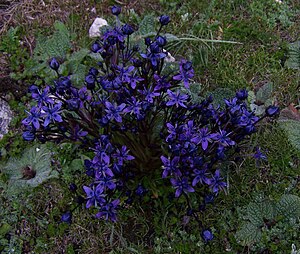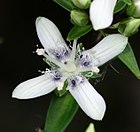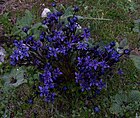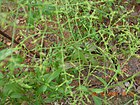Note: This is a project under development. The articles on this wiki are just being initiated and broadly incomplete. You can Help creating new pages.
Swertia chirayita - chirayata
Chirayita is a medicinal plant indigenous to temperate Himalaya. Chirayita has an erect, about 2–3 ft long stem, the middle portion is round, while the upper is four-angled, with a prominent decurrent line at each angle.
Contents
- 1 Uses
- 2 Parts Used
- 3 Chemical Composition
- 4 Common names
- 5 Properties
- 6 Habit
- 7 Identification
- 8 List of Ayurvedic medicine in which the herb is used
- 9 Where to get the saplings
- 10 Mode of Propagation
- 11 How to plant/cultivate
- 12 Commonly seen growing in areas
- 13 Photo Gallery
- 14 References
- 15 External Links
Uses
Stomach problems, Indigestion, Nausea, Bloating, Skin eruptions, Liver problems, Fever, Tuberculosis, Malaria
Parts Used
Chemical Composition
The plant contains a bitter glycoside chiratin, which on hydrolysis yields two bitter principles: ophelic acid, an amorphous bitter hygroscopic principle, and chiratogenin, a yellow bitter glycoside, insoluble in water.[1]
Common names
| Language | Common name |
|---|---|
| Kannada | Nelabevu |
| Hindi | Chirayata, Charaita |
| Malayalam | Kiriyatta, Kiriyattu |
| Tamil | Nilavembu, Shirattakuchi |
| Telugu | Nelavemu |
| Marathi | NA |
| Gujarathi | NA |
| Punjabi | NA |
| Kashmiri | NA |
| Sanskrit | Anaryatikta |
| English | Chirayita |
Properties
Reference: Dravya - Substance, Rasa - Taste, Guna - Qualities, Veerya - Potency, Vipaka - Post-digesion effect, Karma - Pharmacological activity, Prabhava - Therepeutics.
Dravya
Rasa
Tikta (Bitter)
Guna
Laghu (Light), Ruksha (Dry)
Veerya
Sheeta (cold)
Vipaka
Katu (Pungent)
Karma
Kapha, Vata
Prabhava
Habit
Identification
Leaf
| Kind | Shape | Feature |
|---|---|---|
| Simple | Alternate | The leaves are divided into 3-6 toothed leaflets, with smaller leaflets in between |
Flower
| Type | Size | Color and composition | Stamen | More information |
|---|---|---|---|---|
| Unisexual | 2-4cm long | Green-yellow | 5-20 | Flowers are small, stalked, green-yellow, tinged with purple colour |
Fruit
| Type | Size | Mass | Appearance | Seeds | More information |
|---|---|---|---|---|---|
| General | 7–10 mm | clearly grooved lengthwise, Lowest hooked hairs aligned towards crown | - | {{{6}}} |
Other features
List of Ayurvedic medicine in which the herb is used
Where to get the saplings
Mode of Propagation
How to plant/cultivate
Succeeds in a moist humus-rich soil in damp light woodlands, streamsides or the bog garden[200]. Grows best in areas with cool summerse[3]
Commonly seen growing in areas
Pasture areas, Slope areas of Himalayas
Photo Gallery
References
External Links
- Ayurvedic Herbs known to be helpful to treat Stomach problems
- Ayurvedic Herbs known to be helpful to treat Indigestion
- Ayurvedic Herbs known to be helpful to treat Nausea
- Ayurvedic Herbs known to be helpful to treat Bloating
- Ayurvedic Herbs known to be helpful to treat Skin eruptions
- Ayurvedic Herbs known to be helpful to treat Liver problems
- Ayurvedic Herbs known to be helpful to treat Fever
- Ayurvedic Herbs known to be helpful to treat Tuberculosis
- Ayurvedic Herbs known to be helpful to treat Malaria
- Herbs with Whole herb used in medicine
- Herbs with common name in Kannada
- Herbs with common name in Hindi
- Herbs with common name in Malayalam
- Herbs with common name in Tamil
- Herbs with common name in Telugu
- Herbs with common name in Sanskrit
- Herbs with common name in English
- Habit - Herb
- Index of Plants which can be propagated by Seeds
- Herbs that are commonly seen in the region of Pasture areas
- Herbs that are commonly seen in the region of Slope areas of Himalayas
- Herbs
- Ayurvedic herbs that don't have seed photos
- Gentianaceae




